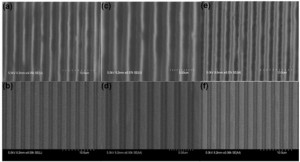Nitroxide Mediated Polymerization (NMP) for Photolithographic Materials
To imprint sub-micron features used for microelectronics applications, 193 nm photolithography has emerged as the method to etch the desired pattern, which is developed using a mask and photoresist polymers. After exposing area not covered by a mask, chemical amplification and changes in solubility of the reacted polymer permit feature reproduction. Such patterns depend critically on the type of polymer used for the photoresist material. Critical factors affecting the production of the features are line width roughness (LWR), resolution limit and sensitivity. LWR, which is key towards attaining smaller feature sizes, depends on the nature of the polymers used. Typically, such photoresist polymers consist of two or more monomers synthesized by conventional free radical polymerization. Although simple to use, conventional free radical polymerization does not permit the control of chain structure, which is intimately related to LWR. Consequently, the development of controlled radical polymerization (CRP) has been identified as the method to produce co/terpolymers with well-defined chain lengths and excellent chain-to-chain homogeneity. The latter is especially important as uniform solubility of chains aids the dissolution process after exposure.
Consequently, variants of CRP such as nitroxide mediated polymerization (NMP), atom transfer radical polymerization (ATRP), reversible addition fragmentation transfer polymerization (RAFT) have been used to make a myriad of polymers/copolymers with controlled microstructures and low polydispersity index. Not surprisingly, such methodologies have been recently targeted to make photoresist materials for 193 nm photolithography. For 193 nm photolithography, copolymers with norbornyl and adamantyl functional groups have been favoured and thus RAFT and ATRP have been initially studied as preferred methods to make photoresist polymers with controlled microstructure. Photolithographic performance was promising as both RAFT and ATRP were able to produce copolymers with defined microstructures and controlled molecular weight distribution. However, the drawbacks of these methods (thiol chain transfer agent and metallic ligand removal), makes alternative controlled polymerization methods desirable. NMP with the next-generation BlocBuilder initiators has not been explored as a route towards resist polymers for 193 nm photolithography, despite its potential advantages compared to ATRP or RAFT in this application. The first part of this project was thus the application of NMP with typical photoresist monomers.
Effect of molecular weight distribution control for conventional radical polymerization (top row) versus nitroxide mediated polymerization (bottom row) for pattern replication. Note that the line width is sharper when using the polymers with narrower molecular weight distributions (adapted from Wang, Z.-J.; Marić, M. “Nitroxide Mediated Synthesis of Low Dispersity Random Copolymers for Low-Loss Optical Waveguides” Polym. Sci. A: Polym. Chem. 2013, 51, 2970-2978).
